Question: I need some help with Bougainvillea care and watering. At the moment the plants are blooming but we will be going out of town, and my “potted bougainvillea” seems to love lots of water.
Can I put saucers under them to try and keep them watered? My sprinkler system will water them every fourth day but I don’t know if that will be enough. I don’t want to lose them and where do they come from? Cindy, Charleston, SC
Answer: The Bougainvillea plant has become a very popular plant for spring and summer color making a great addition for a colorful patio or deck in the backyard.
Let’s give you a general overview of growing Bougainvillea, its care, blooming, light, water, soil, origin and more…
Where Did Bougainvillea Come From and Some History
Bougainvillea vines, are native to the coast of Brazil. They are perhaps the most popular and one of the most widely grown of all tropical vines.
The Bougainvillea (boo-guhn-vil-yuh) is a subtropical or tropical vine in the Nyctaginaceae or Four-O’Clock family.
In the 1768 the French naturalist, Philibert Commerson discovered the colorful vining plant and named it after his friend and captain, Louis-Antoine de Bougainville, a noted lawyer, mathematician, and explorer from Canada.
Many refer and spell the plant name incorrectly as – bouganvilla.
These hardy tropical perennial vines are sometimes called “Paper Flower” because they produce thin, papery, colorful bracts in shades of crimson, purple, orange, yellow, pink and white throughout the spring, summer and fall months when kept in a conducive climate.
They do well in areas where winter temperatures do not drop below freezing, and they are especially suited to southern coastal regions, such as those found in Florida. [source]
The showy plant can be used in a multitude of ways:
How Do You Care For And Grow Bougainvillea Plants?
Size & Growth
Bougainvillea leaves are large and heart-shaped and borne on long, thorny, arching branches.
When kept in a semi tropical or tropical setting outdoors, Bougainvillea can reach a height and spread ranging from 15′ to 40′ feet. The height depends upon the height of the supporting structure.
The plant has two very distinct growth cycles. During the winter months, it is typically in the vegetative growth cycle when it produces new leaves and stem growth.
Ample sunlight will also result in the development of buds during this time. With too little sun, buds will not grow and the plant will simply continue producing leaves.
During the blooming period, the plant displays color as the buds mature and the bracts color up. The healthier the plant and the more direct sunlight it receives, the longer the blooming period will last.
A healthy plant in a conducive environment will have bloom times lasting between 3 and 5 weeks.
When the plant is actively blooming, it will tend to lose a lot of leaves. This should not concern you as they will quickly be replaced in the next growth flush. [source]
Flowering & Fragrance
Most bougainvillea varieties have spiny thorns on cascading stems which end with colorful flower bracts of red, orange, purple and other shades to shield small white, inconspicuous flowers.
Bloom time varies depending upon the sunlight and the temperature. Generally speaking, Bougainvillea blooms best during the time of year when the days and nights are of equal lengths.
In the United States, the peak blooms are typically in the spring and the autumn. In a very tropical setting, late winter might be peak bloom time.
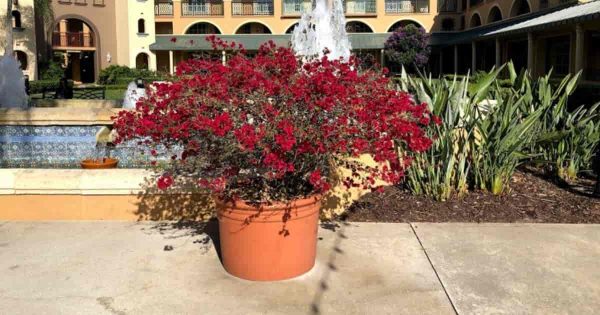 Large Pot of crimson red Bougainvillea at a Disney Resort
Large Pot of crimson red Bougainvillea at a Disney Resort
Light & Temperature
For the best results put your plants in full sun. If you want good blooming give them at least 5 hours of full sun daily as a minimum.
More hours of direct sun is better. Less than 5 hours per day and the plant may not bloom very well.
Your plants will thrive in shade or partial shade, but only have nice growth with little or no blooms.
Bougainvillea is typically kept as an outdoor plant in a tropical setting, but if you live in a colder climate you can keep it in a hanging basket or container indoors or in a greenhouse. Move it outdoors during the warmer months.
Don’t expect your plants to flower indoors. If possible, keep your plants outdoors and give it the maximum sun exposure. Any flowering you may receive indoors is a bonus.
Plants kept indoors typically have excellent vegetative growth but not much in the way of blooms.
When planted outdoors, a southern exposure is best.
Temperature
Bougainvilleas are hardy throughout the South but young growth will be damaged by frost. Optimum growing temperatures are warm days (70°-85° degrees Fahrenheit) and cool nights (60°-70° degrees Fahrenheit).
A light frost will not kill the plant, but you can soon expect all the leaves and bracts to fall off.
In this case, the plant will regrow if not subjected to more frosts for longer duration.
Watering & Feeding
Once established, Bougainvillea are quite drought tolerant and can do well in hot, dry settings. On a newly planted Bougainvillea, keep it well watered until it becomes established and new roots and new growth is evident.
A healthy container-grown Bougainvillea in a pot will drink a lot of water during the warm times of the year. In cooler periods or when you bring your plants indoors for the winter, the water requirement will be much less.
On an ongoing basis, allow the soil around the plant to become nearly dry and then water thoroughly.
SO how much water does Bougainvillea need for proper care and blooming. As always it depends on:
- Soil type
- Root system
- Size of the plant
- Air temperature
Don’t water just to water your plants. Inspect your plants regularly, and learn when they are close to wilting and how much water they need. Then give the plant a good, thorough soaking just before it reaches the wilt stage.
Remember during the summer heat plants will use up water quickly, so inspect often.
Bougainvilla Fertilizing
Mature plants can be heavy feeders. Here are some quick bougainvilla fertilizer tips.
- High phosphorus with micronutrients, as well as additional iron and magnesium
- Timed or slow-release fertilizer like this one are acceptable. Be sure you follow the fertilizer label
- Plants grow best with small amounts of nutrients constantly available
- Do not apply fertilizers to dry soil – Do not overfertilize – in this case less is better than more, also check out applying water-soluble fertilizer
Learn More
If you click this link and make a purchase, we earn a commission at no additional cost to you.
Soil & Transplanting
When planting Bougainvillea bush it’s good to know they handle drought conditions well and thrive in almost any potting soil.
The root system of Bougainvillea is fairly delicate, so the plant needs a fertile, well draining soil. Any well-draining soil that works for other plants you grow beautiful plants.
Many growers feel the plant does best in a soiless media.
The main thing is that the soil should be sharply draining to prevent root rot. Don’t use lots of peat moss or a similar water-retaining substance.
The best pH level is between 5.5 and 6.5.
When growing Bougainvillea in a container, plants seldom need repotting. They grow and bloom best when the root ball is pot bound.
Growers use a potting media like this that drains well but don’t let the plants dry out between waterings. To be successful growing in pots, keep containers moist but they need to be well-drained. No sitting plants in standing water or you are inviting root rot.
DO NOT USE SAUCERS under your potted Bougainvillea.
When repotting Bougainvillea, be sure to dampen the planting media before working with the plant. A very dry soil mixture can damage the plants’ fine roots.
Bougainvillea grows well in almost any kind of container as long as it has ample drainage. Beware of using black containers when placing the plant in full sunlight. They can become dangerously hot.
Grooming & Maintenance
Many homeowners simply let Bougainvillea grow wild, rambling up walls and over fences as it will. Because it is a vine, Bougainvillea stems will continue to grow longer and longer unless they are trimmed back.
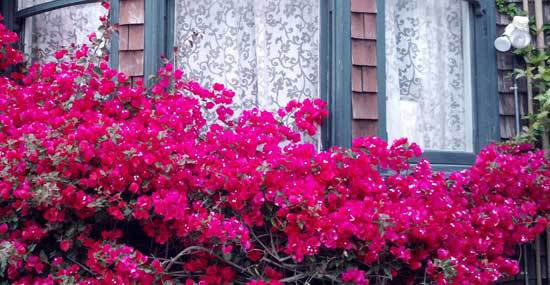 Bright red bougainvillea bloom in front of window
Bright red bougainvillea bloom in front of window
If you want a bushier growth, you should pinch and trim the plant regularly. It tolerates all levels of pruning, trimming and pinching back at any time of the year. It is a good idea to trim after each bloom cycle.
Pruning your bougainvillea to keep the plant within bounds, is necessary. After flowering, cut back the season’s growth severely and remove all thin, weak, or ailing branches. The less-dense the vine, the more outstandingly decorative.
How To Propagate Bougainvillea
Bougainvillea is easy to grow from stem cuttings. Cuttings should be 6″ to 8″ inches long. Coat the ends of each cutting with rooting hormone and poke them into a shallow container of well draining potting medium. A mixture of 50% peat moss and 50% perlite is a good rooting media.
Water deeply and place a plastic bag over the cuttings. Place the pot in a cool setting with dim light.
Leave it alone is much as possible, only watering occasionally to keep the soil slightly moist. You should have a new Bougainvillea plant within 3 to 6 months.
Bougainvillea Pest or Disease Problems
Well cared for Bougainvillea are mostly pest and disease free. Plants that are undernourished or kept in less than ideal settings may fall prey to a wide variety of garden pests, including:
- Bougainvillea Looper Caterpillars
- Spider Mites
- Mealybugs
- Aphids
- Scale
- Snails
- Slugs
The best way to deal with these pests is to avoid having them in the first place by planting in a light, airy soil, watering the right amount, providing the right amount of sunlight and keeping your plants properly pruned and thinned for good air circulation.
if you do have problems with any of these pests or diseases such as root rot, approach the problem with the least toxic method first.
With Bougainvillea, it is far better to rely on beneficial insects for pest control than to resort to chemicals. If you do use a chemical treatment, be sure to follow all safety instructions carefully.
Leaf-eating caterpillars, mites, aphids (get rid of these pests we use this); Leaf spot if foliage and/or soil stays too wet, especially in cool weather. Contact your local nursery or garden center for treating the pest. Always READ AND FOLLOW the label.
Is Bougainvillea Considered Toxic or Poisonous to People, Kids, Pets?
Bougainvillea sap is slightly toxic and should not be ingested at all. It can cause illness if it is ingested in large quantities. The thorns of the plant can cause allergic reactions and skin rash if you are pricked by them.
Is Bougainvillea Considered Invasive?
In a tropical setting, Bougainvillea has a great deal of potential as an invasive plant. It grows rapidly and can smother native plants very quickly. If you live in a tropical setting, take great care that your Bougainvillea does not escape your bounds. [source]
Suggested Bougainvillea Uses
The showy plant can be used in a multitude of ways:
There are over 250 varieties of Bougainvillea in sizes ranging from dwarf to giant perfect for a large pot. It is a very agreeable plant that can be kept successfully as an indoor bonsai, potted plant or tree in cold climates.
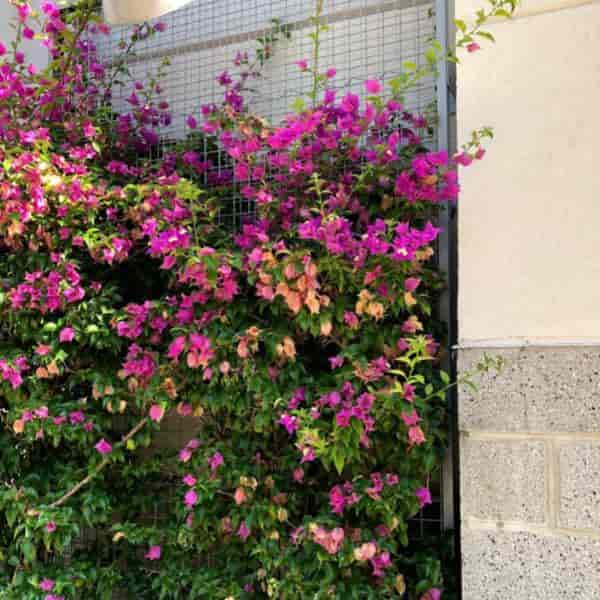 Bougainvillea trained to grow up a trellis in Daytona Beach, FloridaIn a tropical setting, it can be trained to cover any sort of structure to create hedges, privacy screens, topiary sculptures and more. It is the perfect choice to ramble over trellises and gazebos.
Bougainvillea trained to grow up a trellis in Daytona Beach, FloridaIn a tropical setting, it can be trained to cover any sort of structure to create hedges, privacy screens, topiary sculptures and more. It is the perfect choice to ramble over trellises and gazebos.
- Hanging baskets – I find they dry out too quickly in baskets
- 1 to 3-gallon pots either sheared (we like these pruners) as a bush, staked, or as a colorful flowering vine on a trellis.
- Trained as a Bougainvillea tree – standard
- Summer annual up North.
- In the South grown as ground cover, hedge, trellis, standard, or cascading planter plant.
What to Expect When It Arrives at the Garden Center
A growing bougainvillea isn’t fond of changes. Any shipping over 2 days and you may experience some leaf drop and possible total defoliation.
Don’t worry, give your plants a good watering and they’ll come right back out in about 3 to 4 weeks and usually full of flowers.
Tips On Growing Bougainvillea In A Container
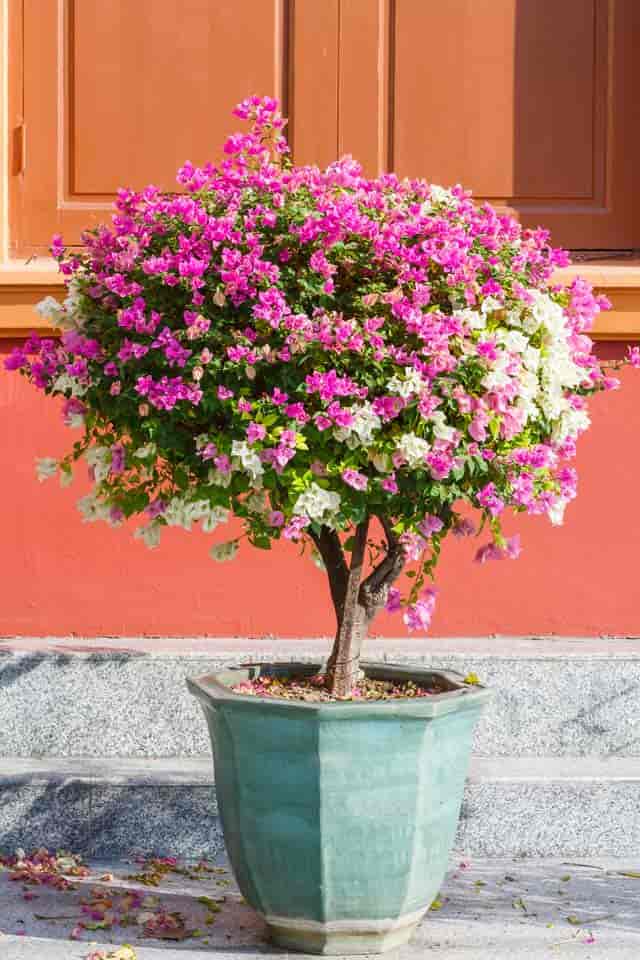 Blooming bougainvillea tree or standard – Spectabilis
Blooming bougainvillea tree or standard – Spectabilis
If you’ve ever wondered about adding Bougainvillea for some summer colors to dress up the patio? Maybe this picture will make you think twice.
Bougainvillea tree or plant is found in many landscapes not only in south Florida but all across the southeast, California and the Mediterranean.
Caring is not difficult when planted in the ground but growing bougainvillea in pots and containers does require care with a watchful eye. Don’t let them dry out!
Bougainvilleas are usually grown as bushes but standards are beginning to find their way in as a spring flowering addition.
The popular Bougainvillea plant derives its name from the paper-thin, brilliantly colored bracts, or scale-like leaves, that form perky geometric frames around the small flowers.
A lax-stemmed, woody perennial in the South, the bougainvillea is a showy subject in Northern greenhouses and in containers in gardens, and for indoors in a large sunny window. It is even tolerant of seashore growing conditions. Originally, the dominant color was magenta-purple; but there are many exotic shades of salmon, orange (Bougainvillea x Buttiana), gold, and red.
Potted Bougainvillea – Good Soil and Drainage
These plants are content with any good soil mix, as long as drainage is provided. Do not allow them sit in puddles of water and make sure the drainage holes do not become plugged.
Potted Bougainvillea flowers best when they receive full sun, and in temperatures of no less than 60° degrees Fahrenheit.
Summer and early fall is the season of active new growth when flower buds are set; generous feeding is helpful during that time. Flowering is reputedly in spring, but my vines – and others I have known – have flowered at intervals all during the year.
Transplant or repot with as little root disturbance as possible. If the vine is frostbitten, simply cut it back to living wood.
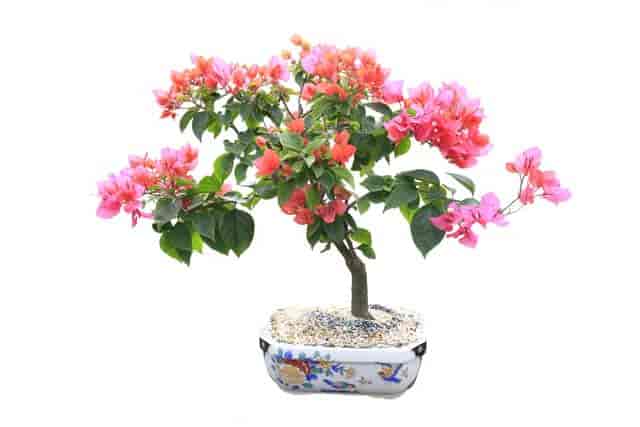 Beautiful Bougainvillea Bonsai in flower
Beautiful Bougainvillea Bonsai in flower
Popular Bougainvillea Varieties
Bougainvillea glabra – The familiar magenta species. Its variety sanderiana is more generous with flowers. Another variety, harrisi, has gray-green foliage variegated with splashes of white. This little beauty flowered for me, in almost transparent lavender, when it was only four inches tall.
Bougainvillea spectabilis (braziliensis) – Hardiest species, with somewhat furry foliage and red-purple blooms.
Family: Nyctaginaceae
Common Name: Paper Flower
Images: Smile | Window
 Large Pot of crimson red Bougainvillea at a Disney Resort
Large Pot of crimson red Bougainvillea at a Disney Resort Bright red bougainvillea bloom in front of window
Bright red bougainvillea bloom in front of window Bougainvillea trained to grow up a trellis in Daytona Beach, Florida
Bougainvillea trained to grow up a trellis in Daytona Beach, Florida Blooming bougainvillea tree or standard – Spectabilis
Blooming bougainvillea tree or standard – Spectabilis Beautiful Bougainvillea Bonsai in flower
Beautiful Bougainvillea Bonsai in flower